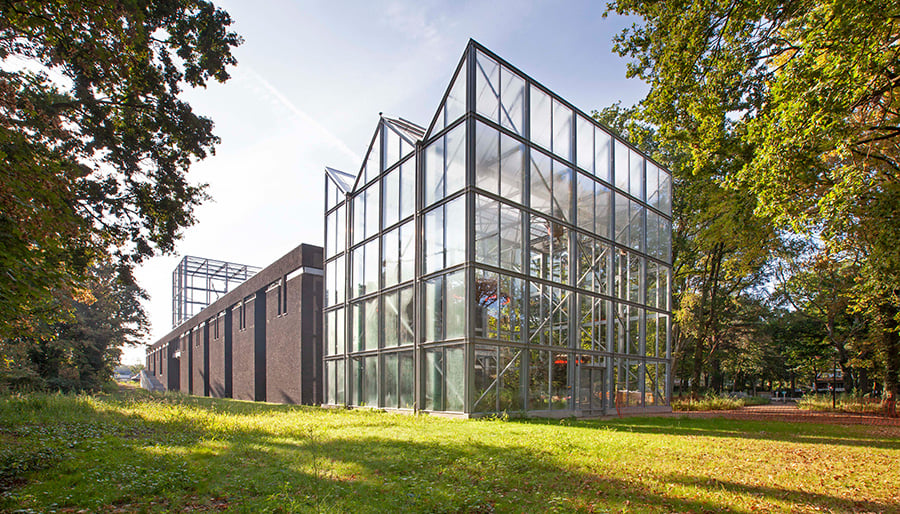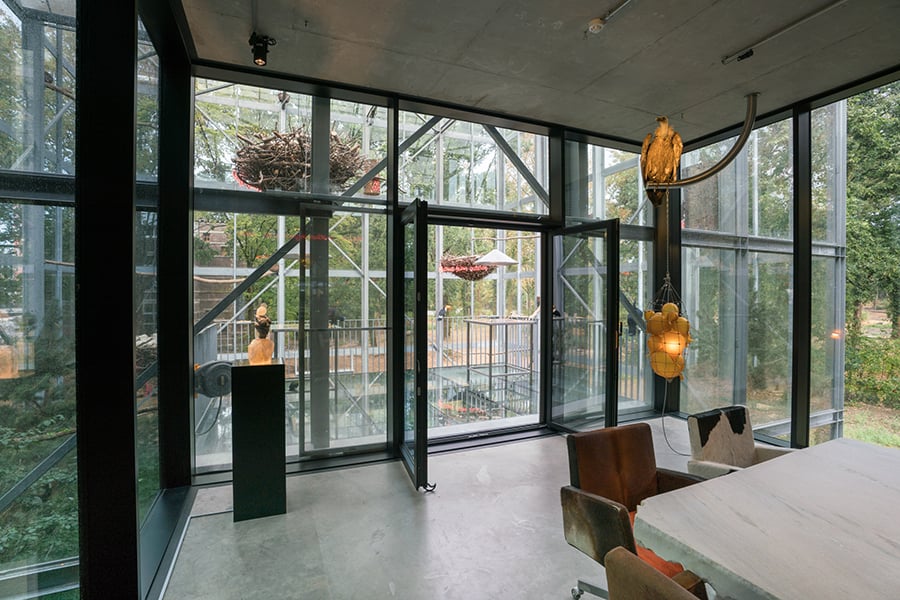
January 31, 2019
LABIOMISTA, a “Reverse Zoo” Anchored by a Mario Botta–Designed Building, Set to Open in 2019
Conceived and led by Belgian artist Koen Vanmechelen, the combination zoo, art studio, and gallery is spread throughout a 60-acre compound.

A new ecology is emerging in the Belgian swampland just outside the old mining town of Genk. Beginning this spring, exotic beasts from around the world will roam free alongside the humblest of farm critters, while ancient species of undomesticated chicken once thought extinct will live within an art-filled arcade designed by Mario Botta.
Known simply as LABIOMISTA (meaning “mixture of life”), the project’s 60 acres are chiefly devoted to the expansive Cosmopolitan Culture Park, a public nature grounds populated by dozens of rare and commonplace animals. Several structures also dot the premises, including a refurbished 20th-century villa and a 53,000-square-foot private studio belonging to the Belgian artist Koen Vanmechelen, who is at the helm of the ambitious endeavor.
With a prolific practice that dates back to the 1990s, Vanmechelen is among the first artists to use animals as his primary medium. Perhaps his best-known work is the The Cosmopolitan Chicken Project (CCP), which goes back two decades and predates the Culture Park at LABIOMISTA. The CCP involves cross-breeding domestic chickens from around the world to achieve maximum diversity and immunity against diseases.
Just as Vanmechelen was preparing to leave his native Belgium in 2015, the mayor of Genk offered up this plot of land for a project of the artist’s choosing. Recalling childhood visits to the old municipal zoo that once stood on the site, Vanmechelen seized the opportunity, devising a new sort of nature park that would place animals and visitors on equal footing.

“This landscape is a wounded space, but if you learn to appreciate the scars, they become your agent,” Vanmechelen explains stoically as an overexcited toucan pecks at his elbow. He stands inside a balmy tropical aviary that’s blinged-out with dangling neon text art and giant artificial nests. It’s one of two bird habitats that bookend his three-floor studio. From the bird-covered balcony, one can just about make out the entrance to the park emerging from the surrounding forestland like a boat run aground.
An elegant mix of polished concrete, birchwood, and black brick, the 2,500-square-foot entrance definitely out-chics the flaming gates of Jurassic Park, though it doesn’t skimp on drama either. Appropriately named the Ark, its towering, prow-like archway seamlessly draws visitors into a glass-lined hallway, where a succession of pop-up exhibitions, a gift shop, welcome center, and more of Vanmechelen’s neon-infused animal artworks ultimately deposit visitors on the doorsteps of the nearby Villa. Built in 1925 by the old mine’s owner, the two-floor neoclassical building will host Vanmechelen’s eclectic collaborators as well as the artist’s Open University of Diversity project when renovation is completed in April.

Exiting the villa, visitors can then traverse the park via a sinuous, sloping, and at times impossibly thin bridge made of concrete aggregate. Nicknamed the Snake, it winds across (and at times above) a roaming pasture cohabited by countless critters including emus, llamas, nandus, and alpacas—all relocated from the artist’s studio just a couple miles down the road—alongside Vanmechelen’s all-star squad of crossbred chickens.
There are no fences or pens in sight: rather, the protective infrastructure for keeping humans and animals at a pleasant distance from each other has been ingeniously engineered into the landscape, thanks to Belgian landscape architects BURO Landschap, in consultation with a team of biologists. At a point of the Snake that feels particularly exposed to the wild, visitors might notice a moat-like ditch a few yards deep on either side of the walkway. These ha-has, or sharp landscaped drop-off points, will keep the roaming ostriches at bay (they can’t walk downhill).
“LABIOMISTA is a reverse zoo, you are a human momentarily inhabiting an animal kingdom,” suggests Vanmechelen. But these animal-centric landscape interventions remain subtle and unobtrusive—you’d be hard pressed to notice most of them.

Further along the winding path, a striking sequence of light grey concrete arches emerge. Cast in situ by the young Spanish-Belgian architecture practice Van Belle & Medina, they give structure to LabOvo, a mixed-use amphitheater that includes a 600-square-foot workshop and a nursing room for LABIOMISTA’s in-house veterinarian. A rooftop terrace will double as a performance space for live performances come summertime.
Reaching the outskirts of the park, the thick woodland drops off entirely, and the scenery is engulfed by a flat plain reminiscent of a savanna. A Dr. Seuss–like artificial hill puffs up in the distance, its bulbous shape peppered with trees. This surreal formation is a surprisingly common site in Genk; it was a means of depositing the detritus of the city’s mines. In the future, this portion of LABIOMISTA will be populated by packs of wolves, as part of a long-term project to re-integrate Vanmechelen’s animals into the wild.
At the north end of the site, Nomad Land—designed by Vanmechelen with picnic tables by the architect-psychologist power team Voet en De Brabandere—will be a marketplace/dining area where visitors can buy produce and meals from local farmers and food trucks. (Nomad Land, while part of the overall project, will be located outside LAMBIOSTA park itself.) Voet en De Brabandere are designing tranquil, domed white picnic areas that will be reminiscent of water lilies; Nomad Land’s bright neon-plated steel signage (also designed by Vanmechelen) could pass for a piece by Martin Creed.

Following the path back to Botta’s black brick studio at dusk, the building’s ominous black brick and glass facade is illuminated by dramatic blood-red lighting. The scene is oddly reminiscent of the Isla Nublar Laboratory from Jurassic Park. As if on cue, dinosaur-like screeches erupt from the second steel enclosure. The shrieking derives from a pair of positively prehistoric Steller’s sea eagles which seem to guard the passage back to reality.
Walking under the raised building, visitors have a final up-close-and-personal encounter with the Steller’s sea eagles through a glass ceiling. If you’re lucky, you might catch the birds perched on the bone-white dead tree that sprouts up from center of the cage, selected by Botta himself. “Botta really took charge of designing the eagles’ residence,” Vanmechelen says with a grin. “But he is not showing off; the whole studio is something to discover—it’s a giant ship going into the world.”
You may also enjoy “The Eerie-Fantastic Interiors of Friedman Benda’s Blow-Up.”














